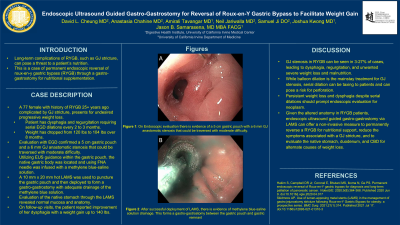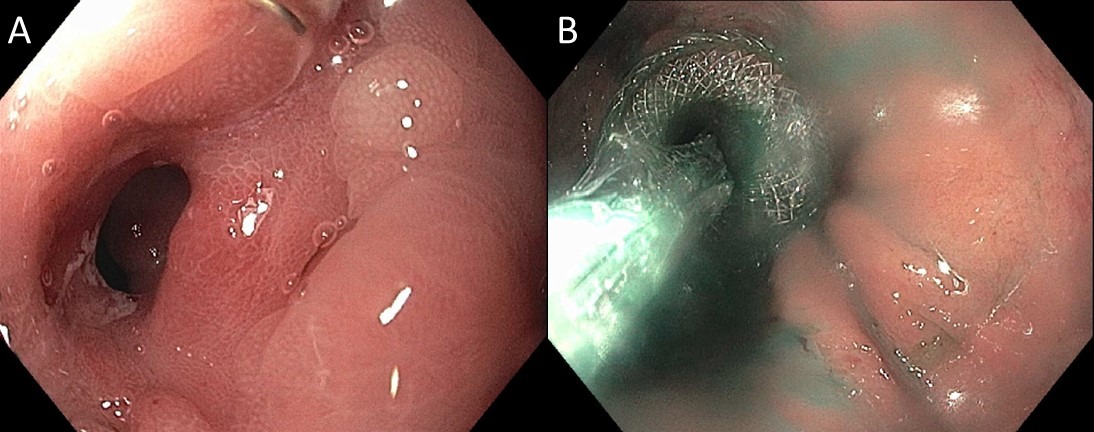Monday Poster Session
Category: Interventional Endoscopy
P2303 - Endoscopic Ultrasound Guided Gastro-Gastrostomy for Reversal of Roux-en-Y Gastric Bypass to Facilitate Weight Gain
Monday, October 23, 2023
10:30 AM - 4:15 PM PT
Location: Exhibit Hall

Has Audio
- DC
David L. Cheung, MD
UC Irvine
Orange, CA
Presenting Author(s)
David L. Cheung, MD1, Anastasia Chahine, MD2, Amirali Tavangar, MD2, Neil Jariwalla, MD2, Samuel Ji, MD2, Joshua Kwon, MD2, Jason Samarasena, MD2
1UC Irvine, Orange, CA; 2University of California Irvine, Orange, CA
Introduction: While the initial intention of Roux-en-Y Gastric Bypass (RYGB) is to lose weight, surgical complications, such as GJ stricture, can pose a threat to a patient’s nutrition. Endoscopic reversal of the RYGB can be achieved through fistulation of the gastric pouch and remnant stomach through gastro-gastrostomy via lumen-apposing metal stent (LAMS). In this case, we present a permanent endoscopic reversal of RYGB through gastro-gastrostomy for nutritional supplementation in a patient with debilitating gastrojejunal (GJ) stricture and failure to gain weight from her RYGB.
Case Description/Methods: A 77 female with history of roux-en-y gastric bypass (RYGB) 25 plus years ago complicated by GJ stricture, presents for undesired progressive weight loss. Since her RYGB, the patient had developed progressive dysphagia and regurgitation requiring serial EGD dilations every 2 to 3 months. Despite the dilations, the patient’s weight went from 120 lbs to 104 lbs over 8 months. Evaluation with EGD confirmed a 5 cm gastric pouch and a 6 mm GJ anastomotic stenosis that could be traversed with moderate difficulty (Image A). Utilizing EUS guidance within the gastric pouch, the native gastric body was located and using FNA needle was infused with a methylene blue-saline solution. A 10 mm x 20 mm hot LAMS was then used to puncture the gastric pouch and then deployed to form a gastro-gastrostomy with adequate drainage of the methylene blue solution (Image B). Evaluation of the native stomach through the LAMS revealed normal mucosa and anatomy. On subsequent follow-up visits, the patient reported improvement of her dysphagia with a weight gain up to 140 lbs.
Discussion: GJ stenosis in RYGB can be seen in 3-27% of cases, leading to dysphagia, regurgitation, and unwanted severe weight loss and malnutrition. While balloon dilation is the mainstay treatment for GJ stenosis, serial dilation can be taxing to patients and can pose a risk for perforation. Furthermore, persistent weight loss and dysphagia despite serial dilations should prompt endoscopic evaluation for neoplasm. Given the altered anatomy in RYGB patients, endoscopic ultrasound guided gastro-gastrostomy via LAMS can offer a non-invasive measure to permanently reverse a RYGB for nutritional support, reduce the symptoms associated with a GJ stricture, and to evaluate the native stomach, duodenum, and CBD for alternate causes of weight loss.

Disclosures:
David L. Cheung, MD1, Anastasia Chahine, MD2, Amirali Tavangar, MD2, Neil Jariwalla, MD2, Samuel Ji, MD2, Joshua Kwon, MD2, Jason Samarasena, MD2. P2303 - Endoscopic Ultrasound Guided Gastro-Gastrostomy for Reversal of Roux-en-Y Gastric Bypass to Facilitate Weight Gain, ACG 2023 Annual Scientific Meeting Abstracts. Vancouver, BC, Canada: American College of Gastroenterology.
1UC Irvine, Orange, CA; 2University of California Irvine, Orange, CA
Introduction: While the initial intention of Roux-en-Y Gastric Bypass (RYGB) is to lose weight, surgical complications, such as GJ stricture, can pose a threat to a patient’s nutrition. Endoscopic reversal of the RYGB can be achieved through fistulation of the gastric pouch and remnant stomach through gastro-gastrostomy via lumen-apposing metal stent (LAMS). In this case, we present a permanent endoscopic reversal of RYGB through gastro-gastrostomy for nutritional supplementation in a patient with debilitating gastrojejunal (GJ) stricture and failure to gain weight from her RYGB.
Case Description/Methods: A 77 female with history of roux-en-y gastric bypass (RYGB) 25 plus years ago complicated by GJ stricture, presents for undesired progressive weight loss. Since her RYGB, the patient had developed progressive dysphagia and regurgitation requiring serial EGD dilations every 2 to 3 months. Despite the dilations, the patient’s weight went from 120 lbs to 104 lbs over 8 months. Evaluation with EGD confirmed a 5 cm gastric pouch and a 6 mm GJ anastomotic stenosis that could be traversed with moderate difficulty (Image A). Utilizing EUS guidance within the gastric pouch, the native gastric body was located and using FNA needle was infused with a methylene blue-saline solution. A 10 mm x 20 mm hot LAMS was then used to puncture the gastric pouch and then deployed to form a gastro-gastrostomy with adequate drainage of the methylene blue solution (Image B). Evaluation of the native stomach through the LAMS revealed normal mucosa and anatomy. On subsequent follow-up visits, the patient reported improvement of her dysphagia with a weight gain up to 140 lbs.
Discussion: GJ stenosis in RYGB can be seen in 3-27% of cases, leading to dysphagia, regurgitation, and unwanted severe weight loss and malnutrition. While balloon dilation is the mainstay treatment for GJ stenosis, serial dilation can be taxing to patients and can pose a risk for perforation. Furthermore, persistent weight loss and dysphagia despite serial dilations should prompt endoscopic evaluation for neoplasm. Given the altered anatomy in RYGB patients, endoscopic ultrasound guided gastro-gastrostomy via LAMS can offer a non-invasive measure to permanently reverse a RYGB for nutritional support, reduce the symptoms associated with a GJ stricture, and to evaluate the native stomach, duodenum, and CBD for alternate causes of weight loss.

Figure: A) 5 cm gastric pouch with a 6 mm GJ anastomotic stenosis that could be traversed with moderate difficulty.
B) Drainage of methylene blue-saline solution after successful deployment of LAMS to form a gastro-gastrostomy between the gastric pouch and gastric remnant
B) Drainage of methylene blue-saline solution after successful deployment of LAMS to form a gastro-gastrostomy between the gastric pouch and gastric remnant
Disclosures:
David Cheung indicated no relevant financial relationships.
Anastasia Chahine indicated no relevant financial relationships.
Amirali Tavangar indicated no relevant financial relationships.
Neil Jariwalla indicated no relevant financial relationships.
Samuel Ji indicated no relevant financial relationships.
Joshua Kwon indicated no relevant financial relationships.
Jason Samarasena: Applied Medical – Advisor or Review Panel Member. Boston Scientific – Consultant. Conmed – Consultant. Cook – Educational Grant. Neptune Medical – Consultant. Olympus – Consultant. Steris – Consultant.
David L. Cheung, MD1, Anastasia Chahine, MD2, Amirali Tavangar, MD2, Neil Jariwalla, MD2, Samuel Ji, MD2, Joshua Kwon, MD2, Jason Samarasena, MD2. P2303 - Endoscopic Ultrasound Guided Gastro-Gastrostomy for Reversal of Roux-en-Y Gastric Bypass to Facilitate Weight Gain, ACG 2023 Annual Scientific Meeting Abstracts. Vancouver, BC, Canada: American College of Gastroenterology.
